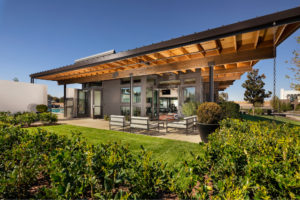2017 Gold Winner – NAHB’s Best in American Living Awards
McKinley Village is an urban village in the core of Sacramento that combines the qualities of the city’s most successful urban neighborhoods with design features that give this neighborhood distinctive character. The 4,200 sf recreation center for a community of 328 homes serves as the community’s civic center; offering a pool, community gathering space, and an area for retail use such as a cafe, restaurant, or yoga studio. Bikeways and walkways stitch together the neighborhood and connect McKinley Village, McKinley Park, Midtown, Sutter’s Landing Park and the American River Parkway.
The project combines the qualities of successful urban neighborhoods with design features that give this neighborhood its distinctive character.
The design of the Recreation Center enhances the character of East Sacramento, with distinguishing neighborhoods like McKinley Park, Meister Terrace and East Portal Park.
As the neighborhood’s community facility, the building was designed with sweeping roof forms and deep overhands that define and engage outdoor spaces while also shading large expanses of glass. The building’s design is enriched by details such as brick patterning, expressive structure, and interconnection to the site.
Natural Ventilation
The McKinley Recreation Center is a 4,200 sf clubhouse with a 34’ tall passive downdraft cooling tower. The tower takes advantage of the prevailing winds, plus the higher relative density of cold air to create passive cooling at a tiny fraction of the cost of traditional mechanical cooling. Air enters the top of the tower where evaporation from a wet medium cools the air. The heavy cold air then naturally falls down the tower into the space below.
The building’s control systems regulate the tower intake. Hot air is exhausted through motorized windows at the top of monitors on the north and down wind side of the building. The resulting system is very simple to operate and maintain because it relies on natural movement of hot and cold air rather than energy intensive compression cooling of the space. It also allows the building to be open to the outdoors during many of the warmer months.






